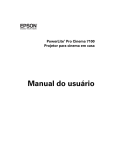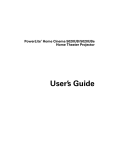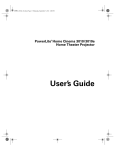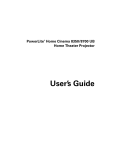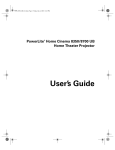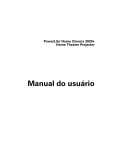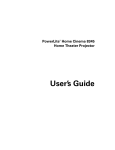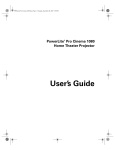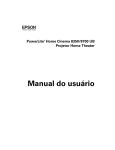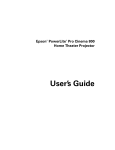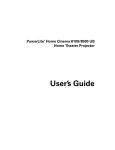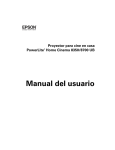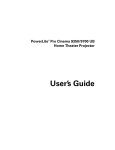Download User`s Guide - Epson America, Inc.
Transcript
® PowerLite Pro Cinema 6010 Home Theater Projector User’s Guide Contents Introduction 2 5 Projector Parts Remote Control Optional Accessories Registration and Warranty Using This Manual 6 8 9 9 10 Setting Up the Projector 11 Choose a Location Installing the Projector Connecting the Cables Connecting Video and Computer Equipment Making Other Connections Installing Batteries in the Remote Control Turning the Projector On and Off Turning On the Projector Turning Off the Projector Selecting the Image Source Positioning the Image 11 15 17 17 19 20 20 20 21 21 22 Making Basic Adjustments 25 Focusing and Zooming Choosing the Aspect Ratio Viewing 3D images Projecting in Split Screen mode Choosing the Color Mode 25 26 27 28 29 Contents Advanced Color Adjustments Adjusting the Gamma Setting Adjusting RGBCMY Locking the Projector 30 31 32 32 Making Detailed Adjustments 34 Using the Menu System Changing How the Menus Display Adjusting the Picture Quality Input Brightness Settings Sharpness and Picture Quality Settings Color Settings 3D Setup Adjustments for Computer Images Split Screen Setup Selecting Memory Settings and Resetting the Projector Creating Memory Settings Selecting Memory Settings Renaming Memory Settings Deleting Saved Memory Settings Resetting the Projector Customizing Projector Features Image Sizing Screen Options Other Setup Options 34 35 36 36 38 39 41 43 43 45 45 45 46 46 47 48 48 49 49 Using HDMI Link 52 Setting Up HDMI Link Changing HDMI Link Settings 52 53 Maintenance 54 Cleaning the Lens Cleaning the 3D Glasses 54 55 Contents 3 4 Cleaning the Projector Case Cleaning and Replacing the Air Filter Replacing the Lamp Resetting the Lamp Usage Timer Checking the Projector Status Storing the Projector Transporting the Projector 56 56 58 61 61 62 62 Problem Solving 63 What To Do When the Lights Come On or Flash Solving Picture Problems Solving Remote Control Problems Where to Get Help 63 65 69 70 Specifications 71 Notices 75 Important Safety Information FCC Compliance Statement Copyright Notice A Note Concerning Responsible Use of Copyrighted Materials Trademarks 75 77 78 78 79 Contents Introduction The PowerLite® Pro Cinema 6010 projector lets you enjoy theater-quality 3D images in the relaxing environment of your own home. Designed especially for home cinema use, it offers these outstanding features: ■ Native 1080p (1920 × 1080) resolution, dynamic contrast ratio up to 200,000:1 and up to 2400 lumens of brightness (color and white light output) for incredibly rich, sharp images in any room lighting ■ Auto Iris system that constantly controls the light output based on the gamma and black/white levels of your projected content, for perfectly adjusted images and deepest blacks ■ Epson C2Fine® 3LCD technology for reliable picture quality, increased contrast ratio and uniform colors ■ 1080Perfect™ video processing for more film-like images free of noise or artifacts ■ 10-bit color quality for unmatched color accuracy, with over a billion colors available ■ HDMI® (High-Definition Multimedia Interface®) ports for superior, uncompressed digital video ■ Built-in cinema filter and Fujinon® lens for exceptional picture quality ■ True 16:9 wide-format projection ■ Flexible setup configurations, including front projection and ceiling mounted, with vertical and horizontal lens shift dials for offset placement Introduction 5 Projector Parts Front Remote receiver Lamp cover Zoom ring Horizontal lens shift dial Vertical lens shift dial Power and warning lights Air exhaust Control panel cover Focus ring Control panel Air filter cover Auto lens shutter Air intake Adjustable foot Projector lens Back Component ports Cable clip holes External 3D IR port HDMI ports Video port Trigger out port (12V DC 200mA max) PC port RS-232C port Power inlet Kensington® lock port Power switch 6 Introduction Bottom Front adjustable feet Mounting bracket attachment points Projector Control Panel Power button Menu button Menu navigation/ vertical keystone buttons Retractable cover Source button Escape button Enter button Introduction 7 Remote Control On button Turns projector on HDMI Link button Enables and disables the HDMI link function Illumination button Lights the remote control buttons for easy viewing Source buttons Switch between equipment connected to the projector 2D/3D button Toggles between 2D and 3D projection HDMI Link control buttons Control playback of a linked video device Menu navigation buttons Color Mode button Quickly change color settings to match room lighting Default button Resets menu selection to default values Super-res button Adjusts the Super-res setting on or off Menu button Displays the projector’s menus Auto Iris button Adjusts the Auto Iris function Split button Adjusts the Split Screen function User button Function can be set by the user from the Settings menu 8 Standby button Turns projector off Introduction Aspect button Changes the picture’s aspect ratio (not available for all sources) Frame Int button Adjusts the Frame Interpolation setting Blank button Temporarily stops projection or hides the menu screen RGBCMY button Displays the color adjustment menu Memory button Accesses the memory menu Pattern button Displays test patterns to adjust the image Optional Accessories Epson provides the following optional accessories for the projector: Product Part number Replacement lamp V13H010L69 Air filter replacement V13H134A39 Kensington security lock (anti-theft device) ELPSL01 Projector mount CHF2500 Computer cable (6 feet [1.8 meters]) F3H982-06 3D active shutter glasses V12H483001 External 3D IR emitter V12H484001 Fixed Anamorphic Lens Kit ELPALK3 In addition to the accessories listed above, 1-year and 2-year extended service plans are available. You can purchase these plans and other accessories from an authorized Epson reseller. To find the nearest reseller, please call 800-GO-EPSON (800-463-7766). To purchase online, visit www.epsonstore.com (U.S. sales) or www.epson.ca (Canadian sales). Registration and Warranty Your projector comes with a basic three-year carry-in warranty. For details, see the Quick Setup sheet. In addition, Epson offers free Extra CareSM Home Service. In the unlikely event of an equipment failure, you won’t have to wait for your unit to be repaired. Instead, Epson will ship you a replacement unit anywhere in the United States, Canada, or Puerto Rico. See your Extra Care Home Service brochure for details. To register, simply follow the registration instructions on the CD, or register online at epson.com/webreg. Registering also lets you receive special updates on new accessories, products, and service. Introduction 9 Using This Manual This book contains all the information you need to use the projector, in addition to basic setup and maintenance instructions, troubleshooting tips, important safety instructions, specifications, and warranty information. Please follow these guidelines as you read through the manual: Warning: Must be followed carefully to avoid bodily injury. Caution: Must be observed to avoid damage to your equipment. Note: Contains important information about your projector. Tip: Contains helpful projection tips. Need additional help? Take advantage of Epson’s automated support services 24 hours a day at epson.com/support (U.S.) or epson.ca/support (Canada). Use this site to view FAQs or product information and e-mail Epson. If you need more help, you can use the Epson PrivateLine® Support service. Call (800) 637-7661 and enter the PIN on the PrivateLine support card that came with your projector. 10 Introduction Setting Up the Projector Follow the instructions in this section to choose a location for the projector, connect the cables, and display an image. Choose a Location You can install the projector for the viewing setups shown below, as well as rear projection. Front Ceiling Setting Up the Projector 11 Ideally, keep the projector level and place it at a height so its lens is centered between the top and bottom of the screen. If this is not possible, use the lens shift dials to reposition the image. As a rule of thumb, you can use lens shift to move the image up or down by nearly its full height, and left or right by about one-half its width (for details, see page 22). Offset A Offset B Projection distance Offset refers to distance from bottom of image to center of lens using maximum lens shift. If you place the projector off to the side, aim it straight ahead (rather than at the center of the screen), then use the horizontal lens shift dial to center the image on the screen. Vertical lens shift dial Horizontal lens shift dial Caution: Do not try to move the lens by hand, or you may damage the projector. Always use the lens shift dials to change the lens position. 12 Setting Up the Projector The size of the image is determined by the distance from the projector’s lens to the screen. Depending on your display settings and how you use the Zoom ring, the actual size may differ. Use these tables as a guide for projector placement: 16:9 aspect ratio Diagonal image size Projection distance (width × height) Offset A Offset B Horizontal Offset 3.8 to 8.3 feet 1.17 to 2.52 m 40 in. (35 × 20 in.) 101.6 cm (89 × 50 cm) 9.1 in. 23 cm 28.7 in. 73 cm –15.4 to 15.4 in. –39 to 39 cm 5.8 to 12.5 feet 1.77 to 3.80 m 60 in. (51 × 28 in.) 152.4 cm (130 × 75 cm) 13.8 in. 35 cm 43.0 in. 109 cm –23.2 to 23.2 in. –59 to 59 cm 7.8 to 16.7 feet 2.38 to 5.08 m 80 in. (71 × 39 in.) 203.2 cm (180 × 100 cm) 18.1 in. 46 cm 57.5 in. 146 cm –30.7 to 30.7 in. –78 to 78 cm 9.8 to 20.9 feet 2.98 to 6.36 m 100 in. (87 × 47 in.) 254 cm (220 × 120 cm) 22.8 in. 58 cm 71.7 in. 182 cm –38.6 to 38.6 in. –98 to 98 cm 11.8 to 25.1 feet 3.59 to 7.64 m 120 in. (106 × 59 in.) 305 cm (270 × 150 cm) 27.2 in. 69 cm 86.2 in. 219 cm –46.1 to 46.1 in. –117 to 117 cm 14.7 to 31.4 feet 4.50 to 9.56 m 150 in. (130 × 75 in.) 381 cm (330 × 190 cm) 33.9 in. 86 cm 107.5 in. 273 cm –57.9 to 57.9 in. –147 to 147 cm 17.7 to 37.7 feet 5.39 to 11.49 m 180 in. (173 × 98 in.) 457 cm (440 × 250 cm) 40.9 in. 104 cm 129.1 in. 328 cm –69.3 to 69.3 in. –176 to 176 cm Diagonal image size Projection distance (width × height) Offset A Offset B Horizontal Offset 4.7 to 10.1 feet 1.44 to 3.09 m 40 in. (32 × 24 in.) 101.6 cm (81 × 61 cm) 11.0 in. 28 cm 35.0 in. 89 cm –18.9 to 18.9 in. –48 to 48 cm 7.1 to 15.3 feet 2.18 to 4.66 m 60 in. (47 × 35 in.) 152.4 cm (120 × 90 cm) 16.5 in. 42 cm 52.8 in. 134 cm –28.3 to 28.3 in. –72 to 72 cm 9.6 to 20.4 feet 2.92 to 6.23 m 80 in. (63 × 47 in.) 203.2 cm (160 × 120 cm) 22.0 in. 56 cm 70.1 in. 178 cm –37.8 to 37.8 in. –96 to 96 cm 12 to 25.5 feet 3.66 to 7.79 m 100 in. (79 × 59 in.) 254 cm (200 × 150 cm) 27.9 in. 71 cm 87.8 in. 223 cm –47.2 to 47.2 in. –120 to 120 cm 14.4 to 30.7 feet 4.40 to 9.36 m 120 in. (94 × 71 in.) 305 cm (240 × 180 cm) 33.5 in. 85 cm 105.5 in. 268 cm –56.3 to 56.3 in. –143 to 143 cm 18 to 38.4 feet 5.51 to 11.71 m 150 in. (118 × 91 in.) 381 cm (300 × 230 cm) 41.7 in. 106 cm 131.5 in. 334 cm –70.5 to 70.5 in. –179 to 179 cm 4:3 aspect ratio Setting Up the Projector 13 4:3 aspect ratio (continued) Diagonal image size Projection distance (width × height) Offset A Offset B Horizontal Offset 24.2 to 51.3 feet 7.36 to 15.62 m 55.5 in. 141 cm 175.6 in. 446 cm –94.1 to 94.1 in. –239 to 239 cm 200 in. (161 × 118 in.) 508 cm (410 × 300 cm) To determine the exact image size when you know the projection distance (or the exact projection distance when you know the desired image size), you can use the Image Size Calculator. This program is available on the Epson website at epson.com/support (U.S.) or epson.ca/support (Canada). Also keep these considerations in mind: ■ Make sure there is plenty of space for ventilation around and under the projector. Do not set the projector on top of loose materials that could block the vents underneath. ■ Make sure the projector is within 9.8 feet (3 m) of a grounded electrical outlet or extension cord. In order to view 3D images correctly, 3D glasses must be worn within proper range of the projector. Use the image below to determine the ideal distance for 3D projection (the shading represents the 3D viewing area): 60º 16.5 ft (5 m) 13 ft (4 m) Use the optional external 3D emitter if you cannot view the 3D image normally or if the projector is located more than 16.5 feet (5 m) from the viewing area. See “Optional Accessories” on page 9 for ordering information. 14 Setting Up the Projector Installing the Projector To install the projector, you first need to determine the location, based on the size of your screen (maximum diagonal image size). Use the tables on page 13 as a guide to positioning the projector. To suspend the projector from a ceiling, you will need the included projector mount designed for the projector. Follow the instructions included with the mount to install the projector. Warning: When installing or adjusting the ceiling mount, do not use adhesives to prevent the screws from loosening and do not use any type of oil or lubricant. These may cause the projector casing to crack and the projector may fall, causing serious injury and serious damage to the projector. If you install the projector on the ceiling, you will need to invert the picture so that it appears right side up. Follow these steps: 1. Press the Menu button on the remote control. 2. Open the Settings menu, then select Projection. 3. Select Front/Ceiling. 4. Press the Menu button to exit the menu system. Setting Up the Projector 15 The following illustrations show the dimensions of the projector: 18.3 in. (466 mm) 9.2 in. (233 mm) 6.2 in. (159 mm) 3.3 in. (83 mm) 11.8 in. (300 mm) 5.9 in. (150 mm) LENS 2.4 in. (60 mm) 15.6 in. (396 mm) 6.3 in. (160 mm) 16 Setting Up the Projector 3.3 in. (83 mm) Connecting the Cables Connecting Video and Computer Equipment You can connect the projector to many types of video equipment, such as a Blu-ray Disc™/DVD player, digital tuner, cable or satellite box, video game console, camcorder, or digital camera. You can also connect it to a desktop or laptop PC or Apple® Mac® system. For details on compatible video formats, see page 73. You can connect up to five pieces of equipment at the same time, using any of the commercially available cables shown below: Port name Video equipment connection Computer connection HDMI1/ HDMI2 Use an HDMI cable (version 1.4 or higher required for 3D): Component Use a component video cable (with RCA-style connectors): — Connect the cable to the three component video ports. Match corresponding colors between the cable and the ports. PC — Use a Mini D-sub, 15-pin monitor cable to connect to a computer RGB (monitor) port: Video Use an RCA video cable: — Setting Up the Projector 17 For best results, connect your video equipment to the HDMI port, if possible. If your equipment doesn’t support HDMI, connect it to either the Component (for high quality, component video) or Video (for composite video) port. Note: You need to use a version 1.4 or higher HDMI cable to use the projector’s 3D features. If you aren’t sure if your HDMI cable is version 1.4 or higher, contact your cable manufacturer. When you connect an HDMI cable to the projector, it is recommended that you fasten it with the included cable clip. Follow the steps below to install the cable clip. Note: The included cable clips will fit most standard, round HDMI cables. The clips may not fit non-round or thick HDMI cables. 1. Connect the HDMI cable to one of the HDMI ports on the projector. 2. Insert the end of the cable clip anchor into the cable clip hole above the HDMI port, as shown below. 3. Place the open cable clip around the HDMI cable, but don’t lock it into place. 4. Slide the cable clip towards the projector and lock the clip onto the HDMI connector. To remove the cable clip, unlock the clip and disconnect the HDMI cable. Then pinch the side of the cable clip anchor and carefully pull it out of the cable clip hole. 18 Setting Up the Projector Making Other Connections Connect the power cable and other cables described below, depending on how you plan to use the projector. ■ Plug the power cable into the projector and a grounded electrical outlet. ■ To use an AV controller with the projector, connect a 9-pin null modem serial cable to the RS-232C port. ■ To connect external devices such as motorized screens, connect a mini-jack stereo (3.5 mm) cable to the Trigger Out port and set the Trigger Out menu option to On. See page 51 for more information. The Trigger Out port uses a 12V DC (200 mA max) signal. ■ To connect the optional External IR 3D Emitter, attach an RJ45 straight cable to both the emitter and the External 3D IR port on the back of the projector. See page 9 for part number and ordering information. Setting Up the Projector 19 Installing Batteries in the Remote Control The remote control uses two AA batteries. Warning: Keep batteries away from children. If a battery is swallowed, contact your doctor immediately. 1. Release the tab and lift open the cover. 2. Insert two new AA batteries as shown. 3. Reinsert the cover and press it down until it clicks into place. Aim the remote control at the screen, or at the front or back of the projector. Make sure you are within 32 feet (10 meters) of the projector. If you suspect the batteries are weak, press the the buttons do not glow, replace the batteries. illumination button. If Turning the Projector On and Off Turning On the Projector 1. Turn on the power switch on the back of the projector. 2. Turn on any connected equipment you plan to use. 3. Press the On button on the remote control or the Ppower button on the projector. Remote control Projector Note: To prevent children from turning on the projector, you can use the Child Lock feature. See page 32 for details. If you’ll be using the projector at an altitude above 4921 feet (1500 meters), turn on High Altitude Mode so the fan can properly cool the projector at the high altitude air pressure. See page 51 for details. 20 Setting Up the Projector The power light flashes while the projector warms up. If you don’t see a picture, you may need to change the image source as described on page 21. Turning Off the Projector 1. Turn off any equipment connected to the projector. 2. Press the Ppower button on the projector twice or press the Standby button on the remote control and wait for the power light to stop flashing. 3. Turn off the power switch on the back of the projector. Caution: Turn off this product when not in use to prolong the life of the projector. Selecting the Image Source The source buttons on the projector and remote control let you switch between images from different pieces of equipment connected to the projector (such as a Blu-ray Disc/DVD player, cable or satellite box, or video game console). Press the Source button on the remote control that corresponds to the port to which your video source is connected. Note: There may be a brief delay when switching between sources. Setting Up the Projector 21 If you press the source button on the projector, you see a list of available sources. Press the source button to move through the list and select the desired source. Note: If an image does not appear, see “Problem Solving” on page 63. To temporarily turn off the image and darken the screen, press the Blank button on the remote control. Press the Blank button again to return to normal viewing. Positioning the Image If the projector is not centered in front of the screen, use the lens shift dials and, if needed, vertical keystone buttons to correct the position and shape of the image. Horizontal lens shift dial Vertical lens shift dial Vertical keystone buttons Note: You can display a test pattern to help adjust the image position by pressing the Pattern button on the remote control. Press the Esc button to turn off the test pattern. 22 Setting Up the Projector The vertical position (V) can be adjusted by up to 96% of the height of the screen, while the horizontal position (H) can be adjusted by up to 47% of the width of the screen. If one side of the image is taller than the other, make sure the projector is parallel to the screen. If necessary, adjust the front feet so that the projector is horizontal. Adjustable feet Note: If the projected image shape is not rectangular, the projector is not level with the screen. It’s best to adjust the physical position of the projector to correct this. If you still can’t correct the image shape by adjusting the position of the projector, use the vertical keystone buttons to fix the image shape. Setting Up the Projector 23 When setting up the projector, make sure that it is placed level to the screen in order to provide the best possible image quality. If you must set up the projector at an angle, use the vertical keystone buttons to correct the image shape. 24 Setting Up the Projector Making Basic Adjustments Follow the instructions in this chapter to make basic adjustments to the image shape, size, color, and quality. For further refinements, see “Making Detailed Adjustments” on page 34. Focusing and Zooming Use the focus ring to sharpen the image. Use the zoom ring to reduce or enlarge the image. Making Basic Adjustments 25 Choosing the Aspect Ratio In many cases, video signals are automatically resized to fit on your screen when Auto is selected as the Aspect setting. You may need to change the size of the image (or aspect ratio) for certain image types by pressing the Aspect button on the remote control. Note: When displaying 720p, 1080i, or 1080p signals through the HDMI or Component video port, the aspect ratio is automatically selected and you cannot change it. If you display a 4:3 image using the Zoom setting, the top and bottom will be cut off. You can use the Zoom Caption Pos. option and other settings to resize and reposition the image. For details, see page 49. For details on how the projector resizes the picture when you choose an Aspect setting, see page 73. Select one of these settings: ■ Normal for standard TV broadcasts, computer images, or images with a 4:3 aspect ratio. ■ Full for images recorded in 16:9 (wide-screen) format and squeeze mode. ■ Zoom for letterbox images. 4:3 image using Normal setting ■ 16:9 image using Full setting Wide for expanding a 4:3 image to 16:9 so it fills the whole screen. This stretches only the right and left sides of the image; the central part is unchanged. 26 Making Basic Adjustments ■ Anamorphic Wide to display images that have a 2.40:1 aspect ratio (such as CinemaScope®) when using a commercially available anamorphic lens (available from Epson—see page 9). Note: If you use this setting without an anamorphic lens, the image fills the screen vertically but not at the correct aspect ratio. Make sure Overscan is set to Off (100%), or the image won’t display correctly (see page 48). If your anamorphic lens has a motorized transport, you can operate it automatically with the Trigger out port (see page 51). ■ Horiz. Squeeze to display images that have a 16:9 or 4:3 aspect ratio when you’ve equipped the projector with a fixed anamorphic lens. Viewing 3D images To view 3D content, you must first connect a 3D-compatible video device to one of the HDMI ports on your projector. You will also need a pair of Epson or Epson-compatible M-3Di active shutter glasses. 1. Turn on and begin playback on the 3D-compatible video device. 2. Press the 2D/3D button on the remote control, if necessary. 3. Press and hold the power button on your 3D glasses for at least one second. The power light will turn green and stay lit for about five seconds. To turn the glasses off, hold the power button for at least one second. The power light will flash three times when the glasses have turned off. See “Solving Picture Problems” on page 65 for 3D troubleshooting tips. Making Basic Adjustments 27 Projecting in Split Screen mode You can use the Split Screen feature to simultaneously project two images from different image sources next to each other. You can control the Split Screen feature using the remote control or the projector menus. The Split Screen feature is only available with certain combinations of video sources. Use the table below to determine which video source combinations are available. HDMI1 HDMI2 Component Video PC HDMI1 — — X X X HDMI2 — — X X X Component X X — X — Video X X X — X PC X X — X — Note: When you use the Split Screen feature, other projector features may not be available and some settings may be automatically applied to both images. Also, you can’t access Split Screen mode when 3D mode is enabled. 1. Press the Split button on the remote control. The currently selected input source moves to the left side of the screen. 28 Making Basic Adjustments 2. Press the Menu button. You see this screen: 3. To select an input source for the other image, select the Source setting, press Enter, select the input source, select Execute, and press Enter. (You can also change image sources, if necessary.) 4. To switch the images, select the Swap Screens setting and press Enter. 5. To change the image sizes, select the Screen Size setting, press Enter, select a sizing option, press Enter, and press Menu to exit. Note: Depending on the video input signals, the images may not appear at the same size even if you choose the Equal setting. 6. To exit the Split Screen feature, press the Split or Esc button. Choosing the Color Mode You can change the Color Mode to automatically adjust brightness, contrast, and color, letting you quickly optimize the projected image for various lighting environments. You can also select a different color mode for each input source—which is useful if you view different types of images from different sources. (For example, you might set the HDMI 1 source to Living Room if it’s usually used for watching movies in the daytime with the blinds closed, and the PC source to Dynamic for playing video games with the blinds open.) Making Basic Adjustments 29 Select the image source you want to adjust, then press the Color Mode button on the remote control. Choose from these settings: ■ Cinema for viewing movies in a dimly lit room. ■ Dynamic for projecting the brightest picture available. ■ Living Room for watching television programs during the day. ■ Natural or THX for projecting natural, accurate colors in a dimly lit room. ■ 3D Dynamic for projecting the brightest 3D picture available (only available when the projector is in 3D Mode). ■ 3D Cinema for viewing 3D movies in a dimly lit room (only available when the projector is in 3D Mode). ■ THX 3D for projecting natural, accurate colors in a dimly lit room (only available when the projector is in 3D Mode). Advanced Color Adjustments To further customize the color and image quality, you can adjust the gamma and individual RGBCMY color tones using the RGBCMY button on the remote control. Note: You can fine-tune these and other color and image quality settings using the projector’s menu system (see page 34). You can also save combinations of picture settings with the Memory feature for easy recall (see page 45). If you don’t like the settings you have selected on a particular menu screen, you can press the Default button to restore the factory settings. 30 Making Basic Adjustments Adjusting the Gamma Setting You can select from five gamma settings (2.0 to 2.4) or customize your own setting from your image or a displayed graph. Lower values will increase the contrast of dark areas, but tend to blur the bright areas. Higher values will darken the light areas. Gamma presets make minor adjustments to mid-tone values. The larger the gamma preset, the lower the midtone values. Changing these settings affects contrast which can be seen as a blur in bright areas. 1. Press the Menu button. Select Image from the main menu. Select Advanced and then Gamma. You see the following displayed on the screen: 2. Do one of the following: ■ Select one of the numeric correction values using the u or d button on the remote control and press the Enter button. You see the setting reflected in the graph on the right. The horizontal axis represents the input signal level, and the vertical axis represents the output signal level. Press the Esc button to exit. ■ Select Customized. Then continue with the next step. 3. Do one of the following: ■ Select Adjust it from the image. You see a gamma icon on the projected image. Use the arrow buttons to move the icon to the area of brightness you want to adjust, then press Enter. The custom gamma graph appears with the channel selected for adjustment. Press the u or d button to adjust and then press Enter to save your setting and exit. ■ Select Adjust it from the graph. When the gamma graph appears, use the l or r button to select the point on the graph that you want to adjust, and then use the u or d button to adjust the settings. Press Enter to save your setting and exit. 4. Press the Menu button to close the menu screen when you’re done. Making Basic Adjustments 31 Adjusting RGBCMY Use this feature to adjust the hue, saturation, and brightness for each of the red (R), green (G), blue (B), cyan (C), magenta (M), and yellow (Y) color components. 1. Press the RBGCMY button. You see the following displayed on the screen: 2. Use the u or d button on the remote control to select the color you want to adjust, and press the Enter button. 3. Select the Hue, Saturation, or Brightness for that color, and use the l or r button to make the adjustment. 4. Press Esc to adjust another color, or press RGBCMY to exit. Note: You can also adjust the offset and gain using the RGB setting in the projector’s menu system (see page 40). Locking the Projector The projector includes two lock settings to prevent the image from being accidentally changed once it’s adjusted, and to keep children from turning on the projector without adult supervision. To access the lock settings, follow these steps: 1. Press the Menu button on the remote control. 2. Select Settings and press the OK button. 3. Select Lock Setting and press the OK button. 32 Making Basic Adjustments 4. Choose from these options: ■ Child Lock to disable the Ppower button on the projector’s control panel unless it is pressed for about 3 seconds. Since you can still use the remote control to turn on the projector, you may want to keep it away from children’s reach. Note: Even if the Child Lock is on, the projector turns on and starts projecting if the rear power switch is turned on when the Direct Power On option is enabled. ■ Control Panel Lock to disable all the buttons on the projector’s control panel except the Ppower button. A lock icon appears on the screen whenever you press a button with Control Panel Lock turned on. To operate the projector, you must use the remote control. To cancel Control Panel Lock, press and hold the Enter button on the projector’s control panel for at least 7 seconds. 5. Press Menu to exit the menu system. If you turned on the Control Panel Lock, the projector buttons are now locked. If you turned on the Child Lock, turn off the projector and let it cool down. The Child Lock takes effect after the cool-down period. Making Basic Adjustments 33 Making Detailed Adjustments You can use the projector’s on-screen menus to make detailed adjustments to the image quality—such as the brightness, contrast, sharpness, and color. You can also change the menu display, sleep mode settings, and other projector features. Using the Menu System You can access the menu system either from the remote control or the buttons on the projector’s control panel. You can access the full menu or a line menu that lets you change selected settings. You can also change the menu language and control how the menus display (see page 35). To display the full menu, press the Menu button on the projector or remote control. You see a display like this one: Main menu options Settings available for the highlighted menu Note: You may see different options, depending on your projector model, input mode, and how your equipment is connected to it. If a menu item or setting is not available, this indicates that the setting does not apply to the current input signal or connection mode. 1. Press the u or d button to highlight a main menu option (Image, Signal, Settings, Extended, Memory, Info, or Reset), then press the Enter button to select it. 2. Press the u or d button to highlight a setting, then press the Enter button. 3. Press the u, d, l, or r button to change settings as necessary. You may have to press the Enter button to confirm your choice. 34 Making Detailed Adjustments 4. When you’re finished, press the Esc button to return to the previous menu or press the Menu button to exit the menu system. To display one of the line menus, press the Enter button. You see a display like this at the bottom of the image: ■ Press the l or r button to adjust the setting. ■ Press the Menu or Esc button to close the line menu when you’re done. Note: When a line menu is displayed, you can press Default on the remote control to reset the menu to its factory setting. Changing How the Menus Display Use these options to control how the menus display. ■ Language Extended > Language Select from 21 languages to use in the menu system. ■ Menu Position Extended > Display > Menu Position Use the arrow buttons to choose a position on the screen for displaying the menu. ■ Menu Color Extended > Display > Menu Color Select a color scheme for displaying the menus. Making Detailed Adjustments 35 Adjusting the Picture Quality Before fine-tuning the image using these adjustments, make sure you have already selected the best Color Mode for your picture and viewing environment, as described on page 29. Then use the settings in this section to finish adjusting the picture to your liking. Most image quality settings are saved independently for each input signal type, input source (Video, HDMI, Component, PC), and color mode. After you finish adjusting the settings for one input source, switch to the other input sources you’ll be using and make any necessary adjustments. Input Brightness Settings If the signal from connected equipment is weak and images appear dark, you can adjust the Brightness and Contrast settings. You can adjust brightness and contrast for each image source and color mode. The Brightness setting controls how much light is produced by the projector, and the Contrast setting adjusts the difference between the bright and dark areas of the projected image. The other settings in this section control how the projector interprets the light and dark areas of the picture. ■ Brightness Image > Brightness Adjust the brightness so it’s suitable for your viewing conditions. For example, if you’re projecting in a brightly lit room or onto an especially large screen, you may need to increase the brightness. Decrease the brightness for dark rooms or small screens; this also reduces power consumption and fan noise, and helps to prolong the life of the lamp. ■ Contrast Image > Contrast This setting adjusts the difference between bright and dark areas. 36 Making Detailed Adjustments ■ Auto Iris Image > Auto Iris When this setting is on, the light output is automatically adjusted according to the brightness of the image. Select either Normal or High Speed to indicate how quickly you would like the projector to respond to changes in the brightness of the image. The setting is stored separately for each image source and color mode. It is best to use High Speed for content that frequently changes from bright to dark images. Normal can be used for all other content. ■ Setup Level Signal > Advanced > Setup Level Note: This setting can be used only when an NTSC (480i) signal is being input through the Video port, or when a video signal is being input through the Component video ports. This setting adjusts the threshold at which dark areas of the image are rendered black (0 IRE). For compatibility with most DVD and video equipment sold in the United States, leave this setting at 0%. Check your video equipment’s specifications to be sure of the correct setting. ■ EPSON Super White Signal > Advanced > EPSON Super White Note: This setting can be used only when the signal is input through the HDMI1 or HDMI2 ports with the Color Mode set to Natural or Cinema (see page 29). If bright parts of the image are washed out or overexposed (when the input signal contains values over 100 IRE), turn this setting on to compensate. ■ HDMI Video Range Signal > Advanced > HDMI Video Range Note: This setting can be used only when HDMI1 or HDMI2 is selected as the image source (see page 21). This setting cannot be used when Epson Super White is set to On. If your video equipment has an HDMI port and you’ve connected it to the projector using an HDMI cable, set the level of the projector to match that of the video equipment. ■ Power Consumption Image > Power Consumption This setting controls the light output from the projector. On Normal, the projector produces a brighter image and the lamp uses more power. To save power and extend the life of the lamp, select ECO. Making Detailed Adjustments 37 Sharpness and Picture Quality Settings If the image looks fuzzy, or if it contains noise or flickering, you can use these settings to correct it. ■ Sharpness Image > Sharpness Use this function to make lines and edges appear more distinct in the image. This setting is stored separately for each image source and color mode setting. You can select Standard to adjust the sharpness of the entire image, or select Advanced to access the following submenu: Note: The Advanced setting cannot be used with a signal input through the PC port. Choose Thin-Line Enhancement to sharpen details such as hair and clothing. Choose Thick-Line Enhancement to sharpen large contours and backgrounds. Choose Vert. Line Enhancement to increase vertical image sharpness. Choose Horiz. Line Enhancement to increase horizontal image sharpness. ■ Progressive Signal > Progressive Converts interlaced to progressive signals. Leave the setting on Film/Auto for viewing movies on a player that produces interlaced output. Select Video for watching videos captured with a video camera. Set to Off when viewing images with a large amount of movement. Note: This setting can be used only when viewing a composite video signal, or 480i or 576i, or 1080i signals input through the Component, HDMI1, or HDMI2 ports (see page 73). ■ Motion Detection Signal > Motion Detection This setting specifies how signals are converted to progressive signals. Select a lower setting for slow-moving or still images (S) or select a higher number for video images (M). Note: This setting can be used only when viewing a composite video signal, or 480i or 576i, or 1080i signals input through the Component, HDMI1, or HDMI2 ports (see page 73). 38 Making Detailed Adjustments ■ Noise Reduction Signal > Advanced > Noise Reduction Note: This is not be available with a signal input through the PC port. This setting reduces flickering of analog images. You can select from 3 levels of noise reduction. ■ Frame Interpolation Signal > Advanced > Frame Interpolation This setting compares the current and previous frames, then creates a frame between them to reduce fuzziness and produce clearer moving images. You can select from 3 levels of frame interpolation. You can also access this setting by pressing the Frame Int button on the remote control. ■ Super-resolution Signal > Super-resolution This setting sharpens blurred images, enhancing the apparent detail of the image. You can select from 3 levels of enhancement. Note that intentionally blurred parts of the image, such as out-of-focus backgrounds, may become sharper. Color Settings If the image colors don’t look correct, you can adjust them using these settings. Use the first three settings described below to make the most visible changes. If you only need to make slight adjustments, you can fine-tune the picture with the remaining settings. Most color settings are stored separately for each image source and color mode. ■ Color Saturation Image > Color Saturation Note: This setting cannot be used with a signal input through the PC port. Adjusts the color intensity of the image. ■ Tint Image > Tint Note: This setting cannot be used with a signal input through the PC port. Shifts the color balance between magenta and green. Making Detailed Adjustments 39 ■ Abs. Color Temp. Image > Abs. Color Temp. Shifts the color balance between red and blue, making the image appear warmer or cooler. ■ Skin Tone Image > Skin Tone Makes fine adjustments to the tint and controls the amount of red or green in the image. Also useful for correcting black-and-white images, if they look tinted. ■ RGB Image > Advanced > RGB Use the RGB settings to fine-tune the color of the image. You can adjust the offset and gain for each signal color (red, green, and blue). Use Offset to adjust darker shades and Gain for the lightest shades. ■ RGBCMY Image > Advanced > RGBCMY Use the RGBCMY settings to adjust the hue, saturation, and brightness of the six color components (red, green, blue, cyan, magenta, yellow). After adjusting each color, press Esc to move to another menu option. You can also access this setting by pressing the RGBCMY button on the remote control. See page 32 for more information. 40 Making Detailed Adjustments ■ Gamma Image > Advanced > Gamma You can select from five gamma settings (2.0 to 2.4) or customize your own setting from your image or a displayed graph. Lower values will increase the contrast of dark areas, but tend to blur the bright areas. Higher values will darken the light areas. See page 31 for more information. ■ Color Gamut Image > Advanced > Color Gamut Note: The Color Gamut setting can only be used when the Color Mode is set to THX (see page 28). You can select from three different color gamut settings according to the source material and locale. Select SMPTE-C for standard definition (USA, Canada, and other regions using NTSC), EBU (PAL) for Europe, or HDTV (all regions). 3D Setup Use the options in the 3D Setup menu to adjust 3D brightness, the 3D display format and other 3D settings. Note: You should only adjust the 3D Format and Inverse 3D Glasses settings if 3D images aren’t displaying correctly. Changing these settings unnecessarily may cause problems with 3D projection. ■ 3D Display Signal > 3D Setup > 3D Display Enables or disables 3D mode. You can also change this setting by pressing the 2D/3D button on the remote control. ■ 2D-to-3D Conversion Signal > 3D Setup > 2D-to-3D Conversion Enable this setting to convert 2D images into 3D content. Making Detailed Adjustments 41 ■ 3D Format Signal > 3D Setup > 3D Format Use this setting to select the 3D format supported by your video device. In most cases, the projector will correctly detect the 3D format when this option is set to Auto. You should only select the 2D, Side by Side, or Top and Bottom formats when your projector doesn’t properly display 3D images. See your video source documentation for information on which mode to select. ■ 3D Depth Signal > 3D Setup > 3D Depth Adjusts the depth of the 3D images. Select the Medium or Strong settings to increase the appearance of the 3D effect. ■ 3D Brightness Signal > 3D Setup > 3D Brightness Adjusts the brightness of 3D images. Select the Medium or High settings if the 3D display is too dark. Note: This setting is not available when 3D Format is set to Auto. ■ Inverse 3D Glasses Signal > 3D Setup > Inverse 3D Glasses Reverses the timing for the left and right shutters on the 3D active shutter glasses. Only enable this function if 3D images are not displaying correctly. ■ 3D IR Emitter Signal > 3D Setup > 3D IR Emitter Select External if you’ve connected an external 3D IR emitter (see “Optional Accessories” on page 9 for ordering information). ■ 3D Viewing Notice Signal > 3D Setup > 3D Viewing Notice Enables or disables the viewing notice that is displayed when 3D mode is activated. 42 Making Detailed Adjustments Adjustments for Computer Images In addition to the settings described previously, you can adjust the Tracking and Sync settings for analog RGB computer images. Normally, these settings are adjusted automatically by the projector. If you notice that the image is blurry or contains dark vertical bands, you may need to adjust the settings yourself. ■ Auto Setup Signal > Auto Setup Leave this setting on so that the projector automatically adjusts the tracking, sync, and position of the image. ■ Tracking Signal > Tracking Adjust the tracking to eliminate vertical bands. It is easiest to adjust the tracking when the image contains a lot of fine detail (such as black text on a white background). Note: This setting is only available with a signal input through the PC port. ■ Sync. Signal > Sync. Adjust the synchronization to eliminate blurriness. For best results, make sure the tracking is properly adjusted first. Note: This setting is only available with a signal input through the PC port. Split Screen Setup Press the Menu button while in Split Screen mode to access this menu. ■ Screen Size Split Screen Setup > Screen Size Adjusts the size of the two screens. Choose Larger Left to increase the size of the left screen, Larger Right to increase the size of the right screen, or Equal to split the display evenly between the two screens. Making Detailed Adjustments 43 Note: Depending on the source and resolution of each input, the two screens may not appear to be of equal size when the Equal option is selected. ■ Source Split Screen Setup > Source Select this option to open the Source menu and select which inputs should be displayed in split screen mode. The Left and Right columns represent the left and right screens. Use the arrow buttons on the remote control to highlight Left or Right for the source you want to display. Press Enter on the remote control to select an option. Once you have finished making your selections for both screens, select Execute to exit the Source menu and apply these settings. Note: Certain combinations of sources can’t be selected. Invalid input combinations will be grayed out. See page 28 for a complete list of available source combinations. ■ Swap Screens Split Screen Setup > Swap Screens Select this option to quickly switch the images on the left and right sides of the split screen display. 44 Making Detailed Adjustments Selecting Memory Settings and Resetting the Projector Your projector comes with 10 memory locations where you can save customized settings to obtain the best picture quality for each of your video inputs. Creating Memory Settings Memory settings can be used to store most of the picture quality settings on page 38 and color settings on page 39. Before saving them to memory, adjust the settings to the desired levels. 1. Press the Memory button on the remote control. 2. Select Save Memory. 3. Select the memory name you want to use, then press the Enter button to save your settings. Note: Saved settings are indicated by a green highlight next to the memory name. If you select a name that is already in use, the existing settings will be erased and new ones saved in their place. Selecting Memory Settings You can easily recall the memory settings by using the Memory button on the remote control. 1. Press the Memory button on the remote control. 2. Select Load Memory. 3. Use the arrow buttons to select the desired setting, then press the Enter button. After a moment, the image appears on the screen using the retrieved settings. Certain settings may not be applied, depending on the input signal. Making Detailed Adjustments 45 Renaming Memory Settings You can rename memory settings so that they are easier for you to recognize. 1. Press the Memory button on the remote control. 2. Select Rename Memory. 3. Select the memory name you want to change, then press the Enter button. The name selection screen is displayed. 4. Do one of the following: ■ To select a name from the displayed preset names, select the desired name and press the Enter button. ■ To create your own name, select Customized and use the keyboard screen to enter the name. Use the arrow buttons to select a character, then press the Enter button. When you have selected all of the characters in your name, select Finish and press the Enter button. Deleting Saved Memory Settings You can clear all your memory settings at once. 1. Press the Menu button on the remote control. 2. Open the Reset menu, then select Reset Memory. 3. Select Yes, then press the Enter button to delete the memory settings. Note: You can delete memory settings one at a time with the Erase Memory setting under the Memory menu. 46 Making Detailed Adjustments Resetting the Projector If the image quality isn’t what you expect, one or more settings may be adjusted improperly. If necessary, you can restore the projector to its factory-default (original) settings. To restore the settings in a specific menu (such as the Image or Settings menu), open that menu, select Reset, and confirm as needed. The example below shows how to reset the Image menu settings: Open the Image menu . . . and select Reset You can also reset the lamp usage timer or restore all the projector settings to their original values. Follow these steps: 1. Press the Menu button on the remote control. 2. Open the Reset menu. 3. Do one of the following: ■ Select Reset Lamp Hours to clear the lamp usage timer and reset it to zero. You should reset the lamp timer only when you install a new projector lamp. See page 61 for more information. ■ Select Reset Memory to clear all memory settings. ■ Select Reset All to return all projector settings to their original defaults (except Input Signal, User Button, Language, and Lamp Hours). Making Detailed Adjustments 47 Customizing Projector Features Use the settings in this section to adjust the image size and position, suppress on-screen text, and select basic setup options. Image Sizing Before adjusting any of these settings, make sure you have already selected an appropriate aspect ratio for the type of picture you’re viewing (see page 26). ■ Overscan Signal > Advanced > Overscan For component and HDMI video formats, this setting lets you see the edges of the image that are not normally visible in the picture (see page 73). If you see interference when you set Overscan to Off, try adjusting the Position as described below. Note: The Auto setting is only available when the input source is HDMI1 or HDMI2. ■ Position Signal > Position Note: This setting cannot be used with a signal input through the HDMI1 or HMDI2 port. Use the arrow buttons to fine-tune the position of the image on the screen. ■ Aspect Signal > Aspect This setting lets you change the aspect ratio of your image, and works the same as pressing the Aspect button on the remote control. See page 26 for more information. Note: When displaying 720p, 1080i, or 1080p signals through the HDMI or Component video port, the aspect ratio is automatically selected and you cannot change it. If you display a 4:3 image using the Zoom setting, the top and bottom will be cut off. You can use the Zoom Caption Pos. option and other settings to resize and reposition the image. For details on how the projector resizes the picture when you choose an Aspect setting, see page 73. 48 Making Detailed Adjustments ■ Zoom Caption Pos. Signal > Zoom Caption Pos. Lets you adjust the shape and position of the image so that subtitles are visible (available only if the Aspect setting has been set to Zoom). Adjust Overscan before changing the zoom position. Screen Options ■ Messages Extended > Display > Messages Turn this setting off if you want to prevent on-screen messages from appearing (such as the no-signal message, or the identifying text that appears when you switch between image sources or color modes). ■ Startup Screen Extended > Display > Startup Screen Turn this setting off if you want to prevent the startup screen from appearing while the projector is warming up. ■ Display Background Extended > Display > Display Background Changes the screen that’s used when the projector is not receiving a signal or when you press the A/V Mute button to temporarily stop projection. Other Setup Options ■ Projection Settings > Projection You can select different options for projecting the image: Front, Front/Ceiling, Rear, Rear/Ceiling. ■ Direct Power On Extended > Operation > Direct Power On Sets projection to start without pressing the P power button on the projector or the On button on the remote control. Note: When Direct Power On is enabled, power surges that occur after a power outage can cause the projector to turn on. Making Detailed Adjustments 49 ■ Video Signal Extended > Input Signal > Video Signal Leave this setting on Auto so the projector can automatically interpret the format, such as NTSC or PAL (for standard TV formats). ■ Component Extended > Input Signal > Component Change this setting to match the type of equipment connected to the Component port. For component video, select Auto to let the projector automatically interpret the signal; or select YCbCr or YPbPr to manually select your video equipment’s signal. ■ Illumination Extended > Operation > Illumination Turn off this setting to deactivate the lights on the projector’s P power button and power light. Use this setting if you find the lights distracting in a darkened room. ■ Sleep Mode Extended > Operation > Sleep Mode Turn off this setting if you don’t want the projector to enter sleep mode. (Sleep mode shuts the projector off automatically when there is no video signal.) Select 5min., 10min., or 30min. as the length of time before shutoff; decreasing the time conserves power and extends the life of the lamp. 30min. is the default setting. To turn the projector back on, press the Ppower button on the projector or the On button on the remote control. ■ Child Lock Settings > Lock Setting > Child Lock Lets you lock the Ppower button on the projector’s control panel to make it more difficult for a child to turn on the projector. See page 32 for more information. ■ Control Panel Lock Settings > Lock Settings > Control Panel Lock Lets you disable all the buttons on the projector’s control panel to prevent the image from being accidentally changed once it is adjusted. See page 32 for more information. 50 Making Detailed Adjustments ■ High Altitude Mode Extended > Operation > High Altitude Mode Adjusts the speed of the fan so it can properly cool the projector at higher altitudes. Turn this setting on if you are using the projector at an altitude of 4921 feet (1500 meters) or higher. Note: The maximum operating altitude is 7500 feet (2286 meters). ■ Trigger Out Extended > Operation > Trigger Out Turn on this setting to have the Trigger out port output a 12-volt signal (max. 200 mA) to lower your projection screen when the projector is running. Select Power to transmit a signal when your projector is turned on, or Anamorphic Wide to engage a motorized anamorphic lens (commercially available) when that aspect ratio is selected. Note: If you change this setting, the new setting will take effect the next time you turn the projector on. Making Detailed Adjustments 51 Using HDMI Link When you connect HDMI CEC-compatible devices to the projector with HDMI cables, you can control them using the HDMI Link control buttons on the projector’s remote control. This lets you use just one remote control to operate many commonly used features on all your devices. In a typical configuration, your DVD player may be connected to the projector through an amplifier or home theater system. Even if the amplifier does not conform to the HDMI CEC standard, you can still use the projector’s HDMI Link control buttons to operate the DVD player as long as the DVD player conforms to the HDMI CEC standard. HDMI HDMI Amplifier DVD player Note: Some HDMI CEC functions may not operate, depending on the connected product’s design and compliance with the HDMI CEC standard. Setting Up HDMI Link To prepare your devices to work with the HDMI Link control buttons, follow these steps: 1. Press the HDMI Link button on the projector’s remote control. 2. Select HDMI Link and set it to On. 3. Press the HDMI Link button to exit the menu system. 52 Using HDMI Link 4. Set up your connected devices so their HDMI CEC-compatible functions are enabled. For details, refer to the device manufacturer’s documentation. Changing HDMI Link Settings 1. Press the HDMI Link button on the projector’s remote control. 2. Select Device Connections. You see this screen: 3. Use the u and d arrow buttons to select the device you want to operate, then press Enter. Devices are listed by type (Player, Recorder, AV System, or Tuner) and by name, if the model number is available. 4. Once the device is selected, use the HDMI Link control buttons on the remote control to operate it. You can also use the On, Standby, Enter, Esc, and arrow buttons. Commonly available functions include turning on the device when it’s in standby mode, starting playback, adjusting the volume, and operating the device’s link menu. In addition, HDMI Link allows your projector and other devices to be turned on and off together: ■ If you turn on a connected device, the projector automatically turns on and switches to the correct input source. Note: The power switch on the back of the projector must be turned on for this to work. ■ If you turn on the projector, connected devices such as an amplifier and DVD player are turned on. If multiple video devices are connected, the one last used is turned on. When you turn off the projector, the connected devices are turned off. Note: The CEC power link function of the connected devices must be enabled for this to work. Using HDMI Link 53 Maintenance Your projector needs little maintenance. All you need to do on a regular basis is keep the lens clean. You also may need to clean the air filter to prevent overheating. Warning: Before cleaning any part of the projector, turn it off and unplug the power cord. Never open any cover on the projector, except as specifically explained in this manual. Dangerous electrical voltages in the projector can injure you severely. The only parts you should replace are the air filter and the lamp. If another part needs replacing, contact your dealer or a qualified servicer. Cleaning the Lens Clean the lens whenever you notice dirt or dust on the surface. Note: Carefully open the lens shutter to clean the lens. Do not clean the lens while the projector is turned on. ■ Use a blower brush that is designed for camera equipment to remove dust from the lens. ■ To remove dirt or smears, use a lens cloth or tissue. If necessary, moisten the cloth with lens cleaner and gently wipe the lens surface. Warning: Do not use a lens cleaner that contains flammable gas. The high heat generated by the projector lamp may cause a fire. 54 Maintenance Caution: Never rub the lens with abrasive materials. Use only lens cleaning fluids that are designed for cleaning optics. Avoid touching the lens with your bare hands to prevent fingerprints on or damage to the lens surface. Cleaning the 3D Glasses Use the included lint-free cloth (do not use paper towels) to gently wipe the 3D glasses whenever you notice dust or dirt on the surface. Caution: Never rub the 3D glasses with abrasive materials. Maintenance 55 Cleaning the Projector Case Before you clean the case, turn off the projector and unplug the power cord. ■ To remove dirt or dust, wipe the case with a soft, dry, lint-free cloth. ■ To remove stubborn dirt or stains, moisten a soft cloth with water and a neutral detergent. Then wipe the case and dry it with a dry cloth. Caution: Never use wax, alcohol, benzene, thinner, or other chemical detergents. These can damage the case. Do not use canned air, or the gases may leave a residue. Cleaning and Replacing the Air Filter Your projector includes an air filter to ensure the best performance. If dust collects on the air filter, clean it as described below. Dust clogs prevent proper ventilation and cause overheating and damage to the projector. You can replace the air filter while the projector is mounted to the ceiling, if necessary. The illustrations here show the projector placed on a table. 1. Press the Ppower button on the projector twice or the Standby button on the remote control, wait for the power light to stop flashing, and turn off the power switch on the back of the projector. The projector cools down. 2. Unplug the power cord. 3. Press in on the inner edge of the air filter cover to release the latch, then pull to remove the cover. 56 Maintenance 4. Remove the air filter as shown. 5. Gently tap both sides of the air filter against a hard surface four or five times to remove loose dust from the air filter. Note: Do not use excessive force when tapping the air filter, or it may crack and become unusable. Do not rinse the air filter in water, or use any detergent or solvent to clean it. Do not used canned air, or the gases may leave a residue. 6. Use a small vacuum cleaner that is designed for computers and other office equipment to remove any remaining dust from the surface of the filter. If you don’t have one, gently clean the filter using a very soft brush (such as a clean artist’s paintbrush). If the dirt is difficult to remove or the filter is broken, replace it. You can purchase air filter part number V13H134A39 from an authorized Epson reseller. To find the nearest reseller, please call 800-GO-EPSON (800-463-7766). To purchase online, visit www.epsonstore.com (U.S. sales) or www.epson.ca (Canadian sales). 7. Insert the air filter as shown. Maintenance 57 8. Insert the outer edge of the air filter cover into the notches on the projector, then press in on the inner edge of the cover to lock it into place, as shown below. Replacing the Lamp The projection lamp lasts for up to 4000 hours in Normal mode. You can use the Info menu to check how long it’s been in use (see page 61). It’s time to replace the lamp when: ■ The projected image gets darker or starts to deteriorate. ■ The projector’s lamp light flashes orange or red at half-second intervals. ■ The message Replace the lamp appears on the screen when you start projecting. Note: Lamp life results will vary depending on mode selected, environmental conditions, and usage. Turn off this product when not in use to prolong the life of the projector. You can purchase lamp part number V13H010L69 from an authorized Epson reseller. To find the nearest reseller, please call 800-GO-EPSON (800-463-7766). To purchase online, visit www.epsonstore.com (U.S. sales) or www.epson.ca (Canadian sales). Be sure to read the “Important Safety Information” on page 75 before replacing the lamp. Warning: Let the lamp cool fully (about 1 hour) before replacing it. In the unlikely event that the lamp has broken, small glass fragments may be present and should be removed carefully to avoid injury. Caution: Never touch the glass portion of the lamp with your bare hands; the invisible residue left by the oil on your hands may shorten the lamp life. Use a cloth or glove to handle the new lamp. 58 Maintenance Follow these steps to replace the lamp: 1. If the projector is on, press the P power button on the projector twice or the Standby button on the remote control and wait for the power light to stop flashing. 2. Turn off the power switch on the back of the projector and unplug the power cord and any cables. 3. Wait about an hour to make sure the lamp is no longer hot. 4. Loosen the screw securing the lamp cover. 5. Remove the lamp cover as shown. 6. Loosen the screws securing the lamp (they don’t come all the way out). Maintenance 59 7. Lift up the lamp handle and gently pull the lamp out of the projector. Warning: The lamp(s) in this product contain mercury. Please consult your state and local regulations regarding disposal or recycling. Do not put in the trash. 8. Gently insert the new lamp into the projector and press the handle down. Tighten the screws. Caution: Don’t touch the glass portion of the lamp assembly. Touching the glass could result in premature lamp failure. 9. Replace the lamp cover. (The projector won’t work if the lamp cover is open or loose.) 60 Maintenance 10. Tighten the lamp cover screw. 11. Reset the lamp usage timer, as described on page 61. Resetting the Lamp Usage Timer After replacing the lamp, plug the projector back in, turn on the power switch on the back of the projector, and press the Ppower button on the projector or the On button on the remote control. Then follow these steps to reset the lamp usage timer: 1. Press the Menu button on the projector or remote control. 2. Use the menu navigation buttons to open the Reset menu, then select Reset Lamp Hours. 3. When you see a confirmation prompt, highlight Yes and press the Enter button. 4. When you’re finished, press the Menu button to exit. The lamp usage timer shows 0H until you’ve used the lamp for at least 10 hours. Checking the Projector Status You can use the Info menu to view information about the current display settings and how long the projection lamp has been in use. To access the Info menu: 1. Press the Menu button on the projector or remote control. Maintenance 61 2. Use the menu navigation buttons to open the Info menu. The following information appears: ■ Lamp Hours ■ 3D Format ■ Source ■ Sync Info ■ Input Signal ■ Video Signal ■ Resolution ■ Deep Color (color depth) ■ Scan Mode ■ Status (error information) ■ Refresh Rate ■ Serial Number Note: The information displayed depends on the currently selected image source. The Lamp Hours shows 0H until you’ve used the lamp for at least 10 hours. The resolution indicates the total number of scan lines in the source signal. The number of visible scan lines depends on the signal format standard and selected display settings (see page 73). Storing the Projector If you need to store the projector for an extended time, do the following: ■ Make sure the temperature of the storage area is within 14 to 140 °F (–10 to 60 °C). ■ Retract the adjustable front feet. ■ Remove the batteries from the remote control. ■ Pack the projector in its original packaging or equivalent. Transporting the Projector Note: Epson shall not be liable for any damages incurred during transportation. The projector contains many glass and precision parts. When shipping the projector for repairs, use the original packaging material if possible. If you do not have the original packaging, use equivalent materials. Do not used materials that can become lodged in the projector vents. Be sure the carrier is capable of transporting fragile equipment and is aware that the projector is fragile. 62 Maintenance Problem Solving This section explains how to interpret the projector’s status lights, solve problems with the picture and remote control, and contact technical support. What To Do When the Lights Come On or Flash The lights on top of the projector indicate the projector’s status and let you know when a problem occurs. If the projector isn’t working correctly, first press the P power button, let the projector cool down, and unplug the power cord. Then plug the power cord back in and turn on the projector. If this doesn’t solve the problem, check the status lights on top of the projector. Note: If the power button and light don’t come on, they may have been turned off using the Illumination setting (see page 50). Lights indicating normal operation Light state Cause and solution All lights are off The projector is turned off. Power light is off, power button is on The projector is in standby mode. Press the P power button on the projector or the On button on the remote control to turn it on. Problem Solving 63 Lights indicating normal operation Light state Cause and solution Power light flashes blue, power button is on The projector is warming up. Wait for the picture to appear. Power light and power button are on Projection is in progress. The projector is cooling down. Wait until the power light stops flashing and remains off. Then press the P power button on the projector or the On button on the remote control to turn it back on. Lights indicating a problem Light state Cause and solution All lights are off The projector is not receiving power. Make sure the power cord is connected securely at both ends. The temperature light flashes orange High-speed cooling is in progress. If the temperature rises further, projection will stop automatically. Make sure there is plenty of space around the projector for ventilation. Clean or replace the air filter if necessary (see page 56). If you are using the projector at an altitude above 4921 feet (1500 meters), turn on High Altitude Mode so the fan can cool the projector properly (see page 51). The temperature light is red The projector is too hot, which turns off the lamp automatically. Let the projector cool for five minutes, then turn it back on. Make sure there is plenty of space around the projector for ventilation. Also, clean or replace the filter if necessary (see page 56). If you are using the projector at an altitude above 4921 feet (1500 meters), turn on High Altitude Mode so the fan can cool the projector properly (see page 51). 64 The lamp light flashes orange The lamp needs to be replaced. The lamp light flashes red There is a problem with the lamp. If you just replaced the lamp, make sure the lamp and its cover are securely installed (see page 58). Turn off the projector and unplug it from the electrical outlet. Wait for the lamp to cool, then remove the lamp and check it for cracks. If the lamp isn’t cracked, reinstall it, plug the projector into an outlet, and turn the power on. If this doesn’t fix the problem, or if the lamp is cracked, contact Epson for assistance (see page 70). Problem Solving Lights indicating a problem Light state Cause and solution The temperature light flashes red Both warning lights are flashing red There is a fan or sensor problem. Turn off the projector and unplug it from the electrical outlet. Then contact Epson for assistance (see page 70). There is an internal problem. Turn off the projector and unplug it from the electrical outlet. Then contact Epson for assistance (see page 70). Solving Picture Problems You cannot turn on the projector. ■ Make sure the power cord is connected and the power switch on the back of the projector is turned on. Then wait a moment for the Ppower button to light up before pressing the Ppower button on the projector or the On button on the remote control. ■ If you’ve set the Control Panel Lock, the control panel buttons are disabled; you must use the remote control to turn on the projector (see page 32). ■ If you’ve set the Child Lock, you have to press the Ppower button on the projector for 3 seconds to turn on the projector, or use the remote control (see page 32). No picture appears on the screen or you see the No Signal message displayed. ■ Press one of the Source buttons on the remote control, or press the source button on the projector, to select the correct input source. Allow a few seconds for the projector to sync up after pressing the button. ■ Press the Blank button on the remote control to make sure the picture hasn’t been turned off temporarily. ■ Check that the power light is on and not flashing, and the lens cover is open. ■ The projector may be in standby (or sleep) mode. If the Ppower button is lit and the power light is off, press the Ppower button to turn the projector back on. ■ Make sure your video equipment is turned on. ■ Make sure your cable(s) are connected correctly (see page 17). Problem Solving 65 3D content does not display or does not display correctly. ■ Press the 2D/3D button on the remote control to switch to 3D viewing mode, if necessary. ■ Make sure you are within the 3D viewing range (see page 11). ■ Check that your video device and media are both 3D-compatible. Refer to the documentation that came with your video device for more information. ■ Press the Menu button on the remote control, select the Signal menu, then 3D Setup, then select 3D Format. Make sure that the Auto option is selected. ■ Make sure the Inverse 3D Glasses option is set to No (see page 41). Only part of the picture is displayed, or the picture is distorted. ■ Press the Aspect button on the remote control to select a different aspect ratio (see page 26). ■ If the Aspect is set to Zoom, you may need to use the Zoom Caption Pos. option to see the top or bottom section of the screen so that subtitles are visible (see page 49). ■ Check the Overscan setting to make sure it’s adjusted correctly (see page 48). ■ Use the Position setting to reposition the image on the screen (see page 48). ■ If you’ve connected a computer and you see only half the image, make sure the computer’s Dual Display setting is turned off. ■ If part of the image is cut off, reset the projector settings (see page 47). You’re using a computer and no picture appears on the screen. If you’re using a Windows® laptop: ■ Press the function key that lets you display on an external monitor. It’s often labeled with an icon such as , but it may also be labeled CRT/LCD. You may have to hold down the Fn key while pressing it. Check your laptop’s manual or online help. On most systems, the key lets you toggle between the LCD screen and the projector, or display on both at the same time. Allow a few seconds for the projector to sync up after pressing it. ■ 66 If the function key doesn’t let you display simultaneously on both screens, you might need to use the Display utility in the Windows Control Panel to make sure that both the LCD screen and external monitor port are enabled. From the Windows Control Panel, open the Display utility. In the Display Properties dialog box, click the Settings tab, then click Advanced. The method for adjusting the setting varies from computer to Problem Solving computer; you may need to click a Monitor tab, then make sure the external Monitor port is set as your primary display or enabled. See your computer manual or online help for details. If you’re using Mac OS X: 1. Open the System Preferences utility and select Displays. 2. Select the VGA Display or Color LCD option, if necessary. 3. Click the Arrange or Arrangement tab. 4. Check the Mirror Displays checkbox. (See your computer manual for details.) The picture is upside-down or reversed. Change the Projection setting in the Settings menu (see page 49). The picture isn’t rectangular. ■ If the image looks like or , make sure the projector is not tilted up or down, then use the vertical keystone buttons to adjust the image (see page 22). The picture contains static or noise. ■ Make sure the Input Signal is set correctly for your connected video equipment (see page 50). ■ If you’re viewing still images and you notice flickering or horizontal lines, turn on the Progressive setting (see page 38). ■ Make sure your cables are securely connected at both ends. ■ If you’re using an extension cable, you may pick up interference if the cable is not adequately shielded. You may need to use a signal amplifier for longer cables. ■ If you’re displaying the same image on your computer and projector screen, try turning off your laptop’s LCD display (see page 66). The picture is blurry. ■ Make sure the Input Signal is set correctly for your video equipment (see page 50). ■ There may be dirt on the lens. Clean the lens as described on page 54. ■ Adjust the focus (see page 25). ■ Make sure the lens is not fogged by condensation. If you’ve just moved the projector from a cold environment, wait a couple of minutes before using it. Problem Solving 67 ■ Adjust the Sharpness setting (see page 38). ■ If you’re projecting from a computer, you may need to adjust the Tracking and Sync settings (see page 43). The colors on the screen don’t look right. 68 ■ Make sure the Input Signal is set correctly for your connected video equipment (see page 50). ■ Press the Color Mode button on the remote control to select a different color mode (see page 29). ■ Make sure your video cables are secure on both ends. ■ Check the brightness and contrast settings (see page 36). ■ Fine-tune the colors with the settings listed on page 39. ■ If the picture looks dark, you may need to replace the lamp. Check the lamp usage timer to see how long the lamp has been in use (see page 61). Replace the lamp if it’s close to the end of its service life (see page 58). Problem Solving Solving Remote Control Problems The projector doesn’t respond to remote control commands. ■ Make sure you’re within about 32 feet (10 m) of the projector, and the remote control is aimed at the projector’s front or back sensor within the ranges shown below. 32 ft (10 m) 32 ft (10 m) 32 ft (10 m) 32 ft (10 m) ■ You may need to replace the remote control batteries (see page 20). Press the illumination button and check if the buttons glow. If they don’t, replace the batteries. ■ Dim the room lights and turn off any fluorescent lights. Make sure the projector is not in direct sunlight. ■ Turn off nearby equipment that emits infrared energy, such as a radiant room heater. ■ Make sure there are no objects between the remote control and the IR receiver. Problem Solving 69 Where to Get Help Internet Support Epson provides technical assistance 24 hours a day at epson.com/support (U.S.) or epson.ca/support (Canada). Here you can access troubleshooting information, download product documentation, and receive technical advice through email. Speak to a Support Representative To use the Epson PrivateLine Support service, call (800) 637-7661 and enter the PIN on the Epson PrivateLine Support card that came with your projector. This is the fastest way of speaking to a live representative, and it’s free. This service is available 6 AM to 6 PM, Pacific Time, Monday through Friday, for the duration of your warranty period. You may also speak with a projector support specialist by dialing one of these numbers: ■ U.S.: (562) 276-4394, 6 AM to 8 PM, Pacific Time, Monday through Friday, and 7 AM to 4 PM, Pacific Time, Saturday ■ Canada: (905) 709-3839, 6 AM to 8 PM, Pacific Time, Monday through Friday Days and hours of support are subject to change without notice. Toll or long distance charges may apply. Before you call, please have the following information ready: ■ Product name (PowerLite Pro Cinema 6010) ■ Product serial number (located on the bottom of the projector or in the projector’s Info menu) ■ Computer configuration, if you’re connected to a computer ■ Description of the problem Purchase Supplies and Accessories You can purchase screens, carrying cases, or other accessories from an authorized Epson reseller. To find the nearest reseller, call 800-GO-EPSON (800-463-7766). To purchase online, visit www.epsonstore.com (U.S. sales) or www.epson.ca (Canadian sales). 70 Problem Solving Specifications General Type of display Poly-silicon TFT active matrix Size of LCD panels 0.74 inch (18.8 mm) wide Lens F=2.00 to 3.17 Resolution (native format) 1920 × 1080 pixels, 1080p Brightness Normal mode: White light output up to 2400 lumens (ISO 21118 standard) Color light output up to 2400 lumens Dynamic contrast ratio Up to 200,000:1 Image size 30 to 300 inches (0.76 to 7.62 m) Projection distance 2.85 to 62.83 feet (0.87 to 19.15 m) Zoom ratio 1 to 2.1 Aspect ratio 16:9 (supports 4:3 to 16:10) Fan noise level Normal mode: 32 dB ECO mode: 22 dB Lamp Note: Lamp life will vary depending on mode selected, environmental conditions, and usage. Brightness decreases over time. Turn off this product when not in use to prolong the life of the projector. Type UHE (Ultra High Efficiency), E-TORL Power consumption 230 W Lamp life 4000 hours (Normal mode) 5000 hours (ECO mode) Part number V13H010L69 Specifications 71 Remote Control Range Approximately 32 feet (10 m) Batteries AA × 2 Dimensions Height 5.6 inches (140 mm), not including adjustable feet Width 17.6 inches (446 mm) Depth 15.6 inches (395 mm); not including lens protrusion Weight 18.0 lb (8.2 kg) Electrical Rated frequency 50/60 Hz AC Power supply 100 to 120 V AC: 2.9 A 200 to 240 V AC: 1.3 A Power consumption 100 to 120 V AC: Operating: 352 W (Normal mode) 262 W (ECO mode) Standby: 0.25 W (with HDMI Link enabled) 220 to 240 V AC: Operating: 342 W (Normal mode) 252 W (ECO mode) Standby: 0.35 W (with HDMI Link enabled) Environmental 72 Temperature Operating: 41 to 95 °F (5 to 35 °C) Storage: 14 to 140 °F (–10 to 60 °C) Humidity Operating: 20 to 80% RH, non-condensing Storage: 10 to 90% RH, non-condensing Operating altitude Up to 7500 feet (2286 meters); over 4921 feet (1500 meters), enable High Altitude mode in the Operation menu (see page 51) Specifications Safety United States FCC Part 15B Class B (DoC) UL60950-1 2nd edition Canada ICES-003 Class B CSA C22.2 No. 60950-1-07 Pixelworks DNX™ ICs are used in this projector. Compatible Video Formats The projector supports analog video in NTSC, PAL, and SECAM formats, and it automatically adjusts to the incoming signal. It can receive these formats as composite or component video—which it accepts through the Video and Component ports, respectively. The projector also supports digital video (SDTV, HDTV) and various monitor display formats. Digital video is accepted by the HDMI and Component video ports. The PC port accepts analog RGB computer monitor signals. If necessary, you can select a different Aspect setting to optimize the image. The resolution at which the image displays for a given setting depends on the currently active picture source, as listed in the following tables. Composite video Format Refresh rate (Hz) Resolution NTSC 60 720 × 480 PAL 50/60 720 × 576 SECAM 50 720 × 576 Format/ Signal Refresh rate (Hz) Resolution SDTV 480i 576i 480p 576p 60 50 60 50 720 × 480 720 × 576 720 × 480 720 × 576 HDTV 720p 1080i 1080p 50/60 50/60 50/60 1280 × 720 1920 × 1080 1920 × 1080 Component video Specifications 73 Analog RGB (computer display) Signal Refresh rate (Hz) Resolution VGA 60/72/75/85 640 × 480 SVGA 56/60/72/ 75/85 800 × 600 XGA 60/70/75/85 1024 × 768 SXGA 70/75/85 60/75/85 60/75/85 1152 × 864 1280 × 960 1280 × 1024 WXGA 60 60 60/75/85 1280 × 768 1360 × 768 1280 × 800 Signal Refresh rate (Hz) Resolution VGA 60 640 × 480 SDTV 480i 576i 480p 576p 60 50 60 50 720 × 480 720 × 576 720 × 480 720 × 576 HDTV 720p 1080i 1080p 50/60 50/60 24/50/60 1280 × 720 1920 × 1080 1920 × 1080 Signal Refresh rate (Hz) Resolution HDTV 720p 1080i 1080p 50/60 50/60 24/50/60 1280 × 720 1920 × 1080 1920 × 1080 HDMI 3D mode ESC/VP21 Command Codes You can use an AV controller with a 9-pin null modem serial cable to control the projector. You can download the complete ESC/VP 21 Communication Manual for home theater projectors from the Epson website at epson.com/support (U.S.) or epson.ca/support (Canada). 74 Specifications Notices Important Safety Information Follow these safety instructions when setting up and using the projector: ■ Never look into the projector lens when the lamp is turned on; the bright light can damage your eyes. Never let children look into the lens when it is on. ■ If you or any viewer experiences the following symptoms or other major discomfort from viewing 3D video images, immediately stop viewing and contact your health care provider: convulsions, eye or muscle twitching, loss of awareness, altered vision, involuntary movements, disorientation, eye strain, nausea/vomiting, dizziness, headaches, fatigue, or blurry/double vision that lasts longer than few seconds. Do not engage in any potentially hazardous activity (such as driving a vehicle or operating machinery) until your symptoms have completely gone away. If the symptoms persist, discontinue use and do not resume stereoscopic 3D viewing without discussing your symptoms with a health care provider / physician. ■ Some viewers may experience a seizure or blackout when exposed to flashing images or lights contained in certain 3D content. Anyone who has a history of seizures, loss of awareness, symptoms linked to an epileptic condition, or has a family history of epilepsy, should contact a health care provider before using the 3D function. It is recommended that all viewers take regular breaks while watching 3D video images or playing stereoscopic 3D games. The suggested breaks are, at least 5 to 15 minutes after every 30 to 60 minutes of stereoscopic 3D content viewing.* *Based on the guidelines issued by the 3D Consortium revised December 10, 2008. The length and frequency of necessary breaks will vary from person to person. If you experience any discomfort, you should immediately stop watching the 3D video images or playing stereoscopic 3D games until the discomfort ends; consult a heath care provider / physician if necessary. ■ Due to the possible impact on vision development, viewers of 3D video images should be age 6 or older. Children and teenagers may be more susceptible to health issues associated with viewing in 3D and should be closely supervised to avoid prolonged viewing without rest. ■ Watching the screen while sitting too close for an extended period of time may cause eye strain. Consult your projector manual to determine the ideal viewing distance. ■ Viewing 3D content may cause dizziness and disorientation for some viewers. Therefore, to avoid injury do not place your projector or screen near open stairwells, balconies, or wires, and do not sit near objects that could be broken if accidentally hit. Notices 75 76 ■ The following people should limit 3D content viewing: People with a history of photosensitivity People with heart disease People in poor health People who are sleep deprived People who are physically tired People under the influence of drugs or alcohol Anyone who has ever experienced epileptic seizures or sensory disturbances triggered by flashing light effects SOME LIGHT PATTERNS MAY INDUCE SEIZURES IN PERSONS WITH NO PRIOR HISTORY OF EPILEPSY. ■ Never open any cover on the projector, except the lamp and filter covers. Dangerous electrical voltages inside the projector can severely injure you. ■ Except as specifically explained in this User’s Guide, do not attempt to service this product yourself. Refer all servicing to qualified service personnel. ■ The projector and its accessories come packaged in plastic bags. Keep plastic bags away from small children to avoid any risk of suffocation. ■ Don’t place the projector on an unstable cart, stand, or table. Also, don’t use the projector near water or sources of heat. ■ Use the type of power source indicated on the projector. If you’re not sure of the power available, consult your dealer or power company. ■ Place the projector near a wall outlet where the plug can be easily unplugged. ■ Don’t insert the plug into an outlet with dust present, and insert the plug firmly into the outlet. Failure to do so could result in sparks or fire. ■ Don’t overload wall outlets, extension cords, or integral convenience receptacles. This can cause fire or electric shock. ■ Don’t block the slots and openings in the projector case. They provide ventilation and prevent the projector from overheating. Don’t operate the projector on a sofa, rug, or other soft surface, or in a closed-in cabinet unless proper ventilation is provided. ■ Never push objects through the cabinet slots or spill liquid into the projector. ■ Unplug the projector from the wall outlet and refer servicing to qualified service personnel under the following conditions: when the power cord or plug is damaged or frayed; if liquid has been spilled into the projector, or if it has been exposed to rain or water; if it doesn’t operate normally when you follow the operating instructions, or if it exhibits a distinct change in performance, indicating a need for service; if it has been dropped or the housing has been damaged. ■ Don’t place the projector where the cord can be walked on. This may result in fraying or damage to the plug. ■ Unplug the projector from the wall outlet before cleaning. Use a damp cloth for cleaning. Do not use liquid or aerosol cleaners. ■ The lamp(s) in this product contain mercury. Please consult your state and local regulations regarding disposal or recycling. Do not put in the trash. Notices ■ Allow the lamp to cool for one hour before replacing it. ■ Unplug the projector during lightning storms or when not in use for extended periods. ■ Don’t place the projector or remote control on top of heat-producing equipment. ■ If you use the projector in a country other than where you purchased it, use the correct power cord for that country. ■ Don’t stand on the projector or place heavy objects on it. ■ Don’t use the projector outside of the required temperature range of 41 to 95 °F (5 to 35 °C). Doing so may cause an unstable display and could lead to projector damage. ■ Don’t store the projector outside of the required temperature range of 14 to 140 °F (–10 to 60 °C) or in direct sunlight for long periods of time. Doing so may cause damage to the case. WARNING: The cords included with this product contain chemicals, including lead, known to the State of California to cause birth defects or other reproductive harm. Wash hands after handling. (This notice is provided in accordance with Proposition 65 in Cal. Health & Safety Code § 25249.5 and following.) FCC Compliance Statement For United States Users This equipment has been tested and found to comply with the limits for a Class B digital device, pursuant to Part 15 of the FCC Rules. These limits are designed to provide reasonable protection against harmful interference in a residential installation. This equipment generates, uses, and can radiate radio frequency energy and, if not installed and used in accordance with the instructions, may cause harmful interference to radio or television reception. However, there is no guarantee that interference will not occur in a particular installation. If this equipment does cause interference to radio and television reception, which can be determined by turning the equipment off and on, the user is encouraged to try to correct the interference by one or more of the following measures: ■ Reorient or relocate the receiving antenna. ■ Increase the separation between the equipment and receiver. ■ Connect the equipment into an outlet on a circuit different from that to which the receiver is connected. ■ Consult the dealer or an experienced radio/TV technician for help. Notices 77 WARNING The connection of a non-shielded equipment interface cable to this equipment will invalidate the FCC Certification of this device and may cause interference levels which exceed the limits established by the FCC for this equipment. It is the responsibility of the user to obtain and use a shielded equipment interface cable with this device. If this equipment has more than one interface connector, do not leave cables connected to unused interfaces. Changes or modifications not expressly approved by the manufacturer could void the user’s authority to operate the equipment. For Canadian Users This Class B digital apparatus meets all requirements of the Canadian Interference-Causing Equipment Regulations. Cet appareil numérique de la classe B respecte toutes les exigences du Règlement sur le materiel brouilleur du Canada. Copyright Notice All rights reserved. No part of this publication may be reproduced, stored in a retrieval system, or transmitted in any form or by any means, electronic, mechanical, photocopying, recording, or otherwise, without the prior written permission of Seiko Epson Corporation. The information contained herein is designed only for use with this Epson product. Epson is not responsible for any use of this information as applied to other products. Neither Seiko Epson Corporation nor its affiliates shall be liable to the purchaser of this product or third parties for damages, losses, costs, or expenses incurred by purchaser or third parties as a result of: accident, misuse, or abuse of this product or unauthorized modifications, repairs, or alterations to this product, or (excluding the U.S.) failure to strictly comply with Seiko Epson Corporation’s operating and maintenance instructions. Seiko Epson Corporation shall not be liable for any damages or problems arising from the use of any options or any consumable products other than those designated as Original Epson Products or Epson Approved Products by Seiko Epson Corporation. A Note Concerning Responsible Use of Copyrighted Materials Epson encourages each user to be responsible and respectful of copyright laws when using any Epson product. While some countries’ laws permit limited copying or reuse of copyrighted material in certain circumstances, those circumstances may not be as broad as some people assume. Contact your legal advisor for any questions regarding copyright law. 78 Notices Trademarks Epson, PowerLite, and C2Fine are registered trademarks, 1080Perfect is a trademark, and Epson Exceed Your Vision is a registered logomark of Seiko Epson Corporation. PrivateLine is a registered trademark, DigiScan and AccuCinema are trademarks, and Extra Care is a service mark of Epson America, Inc. HDMI, the HDMI logo, and High-Definition Multimedia Interface are registered trademarks of HDMI Licensing, LLC. General Notice: Other product names used herein are for identification purposes only and may be trademarks of their respective owners. Epson disclaims any and all rights in those marks. This information is subject to change without notice. © 2011 Epson America, Inc. 11/11 CPD-35489 Notices 79




















































































